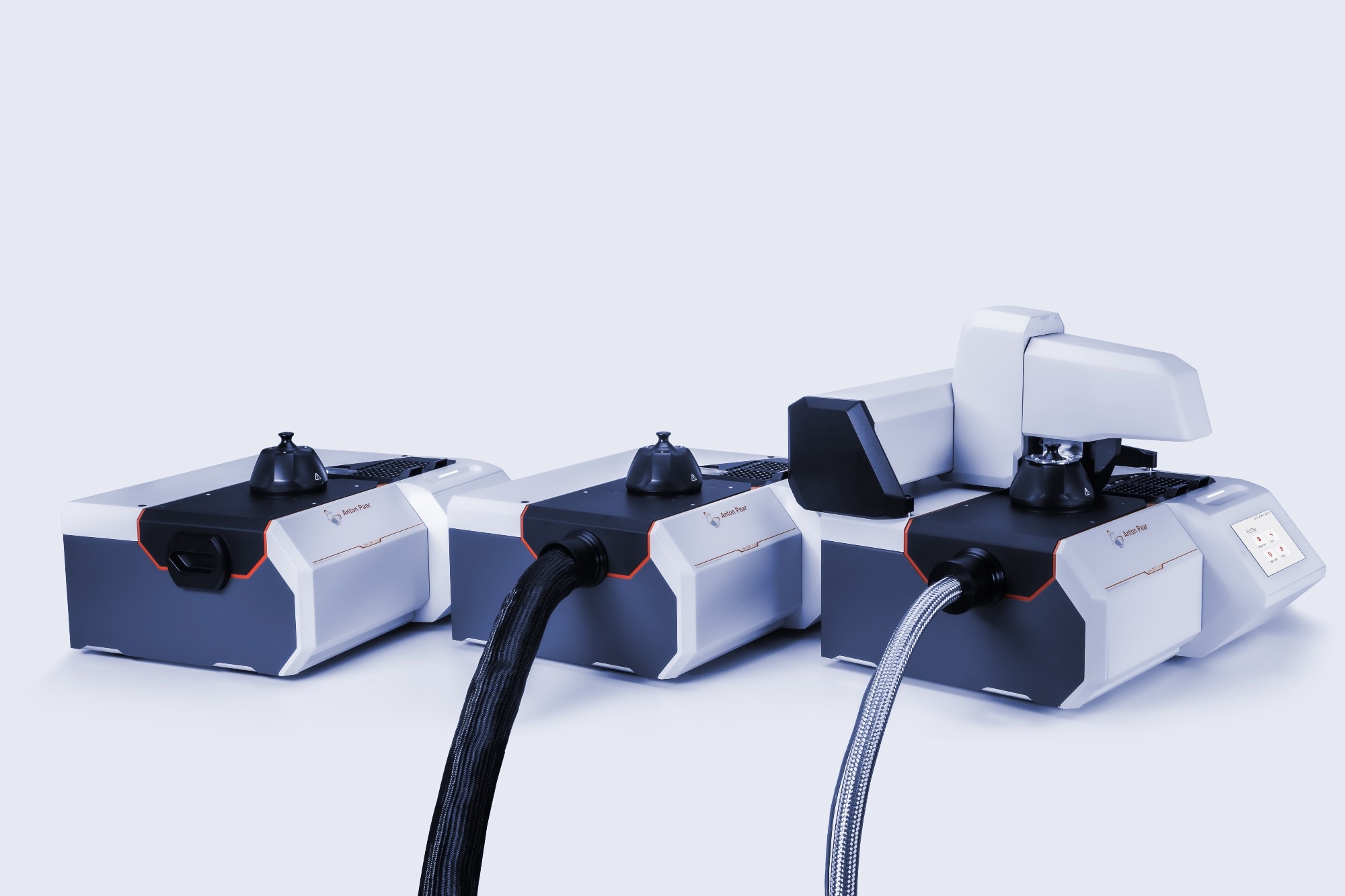The Julia DSC provides advanced thermal analysis with patented air cooling, modular design, and intuitive software, enhancing efficiency in any lab environment. In this interview, Jiri Kislinger delves into the device and how it works.
Can you give us a quick overview of what the Julia DSC is and what it’s designed for?
Julia DSC is Anton Paar’s newest generation of high-performance differential scanning calorimeters, built from the ground up to make thermal analysis faster, simpler, and more accessible. We designed it for both R&D and routine quality control, covering polymers, pharmaceuticals, and the materials used in energy storage, food, or even construction.
The system delivers high accuracy and precision but without the traditional complexity of DSC operation. With integrated cooling, smart automation, and intuitive Julia Suite software, Julia DSC transforms what was once a specialist tool into a plug-and-play instrument suitable for any lab environment.
What sets Julia DSC’s patented Air Cooling Module apart from traditional cooling systems?
Traditional air-cooled DSCs can only reach around-ambient temperatures. Their cooling rates are poor, and the cooldown between measurements takes tens of minutes. Improved cooling is usually achieved with external chillers or liquid coolants that add tubing and maintenance or operational overhead.
Based on advanced Peltier technology, Julia DSC’s patented Air Cooling Module delivers efficient sub-ambient performance without any external hardware. The cooling is built directly into the instrument, making installation and operation almost effortless: simply plug the instrument in and start measuring. It’s an engineering change with a big operational impact, especially for labs that value uptime and simplicity.
Why is liquid-free sub-zero cooling such a game-changer for thermal analysis?
Liquid-free sub-zero cooling removes the need for external chillers with cryogenic fluids or compressor-based systems. This translates to faster setup, fewer maintenance requirements, no environmental or safety concerns, and the added advantage of space efficiency.
Reaching -35 °C using integrated cooling technology enables users to study transitions and processes that were previously only available to labs with dedicated external infrastructure. It’s efficient, clean, and sustainable, which is precisely what modern analytical instrumentation should be aiming for.

Image Credit: Anton Paar
How does the fast-swappable cooling module enhance flexibility in real-world labs?
We know that many labs analyze a wide range of materials. Some need performance around or above ambient temperatures, while others perform extreme low-temperature experiments. That’s why Julia DSC features a fast-swappable cooling module design.
You can replace one module with another in a few minutes using just four screws. This allows users to extend their temperature range, down to -90 °C or even -170 °C, for instance, without investing in a new instrument. The highly flexible architecture adapts to evolving lab needs and workflows.
How does Julia Suite make the system truly plug-and-play for new users?
Julia Suite was developed to remove the intimidation factor from DSC operation. It walks users through the entire workflow, from sample and method setup to experiment and data analysis.
The interface is designed around practical tasks rather than instrument parameters, so even new operators can retrieve meaningful results quickly. The result is faster onboarding, fewer training hours, and more consistent results, no matter who’s operating the instrument.
How does the software simplify calibration and quality control?
Calibration and QC are built directly into Julia Suite. The software includes smart wizards that guide users through heat flow, temperature, and enthalpy calibration using predefined materials and conditions. A dedicated QC mode enables user-definable pass/fail criteria and includes a control chart for trend monitoring to simplify routine tasks.
These features eliminate guesswork and standardize workflows between operators or sites, which is key to maintaining data integrity over time. With Julia Suite, users don’t have to rely on deep DSC expertise–maintaining accurate and repeatable results becomes routine, not an extra chore.

Image Credit: Anton Paar
What features help speed up the entire measurement-to-analysis cycle?
Speed in thermal analysis is about more than heating rates. Julia DSC integrates fast heating and cooling so users can complete experiments quickly, but it also supports automation and smart software features to cut non-measurement time. The autosampler handles up to 70 samples for unattended operation, while the software enables automatic analysis macros and direct export.
From loading samples to viewing results, the workflow is streamlined and efficient. That means higher throughput, faster decision-making, and better instrument utilization, key productivity metrics in any busy materials lab.
How did Anton Paar develop Julia DSC from the ground up?
We started with a simple challenge. Although DSC performance had improved over the years, usability had not.
So, we reimagined the core parts of the instrument and operation processes based on the needs of modern labs, from automation to compactness, modular cooling, and guided workflows.
That required designing the mechanics, electronics, and software together, not separately. We also gathered extensive feedback from users worldwide to understand where existing systems were hindering their progress. The result isn’t just an incremental update, but a completely reimagined DSC platform that lowers barriers to entry and keeps pace with real-world lab dynamics.
Was there a key moment or innovation that really shaped the final product?
Yes. The turning point was realizing that Peltier-based cooling could replace bulky chillers without compromising precision. Once we achieved reliable -35 °C performance purely with air, everything else fell into place: the compact footprint, modular design, and plug-and-play usability.
It fundamentally changed how we thought about DSC architecture. From that point, we focused on simplifying the user experience and minimizing setup complexity. That single breakthrough enabled many of Julia DSC’s signature advantages and set the foundation for future models.
How does Julia DSC handle the wide range of materials and industries it targets?
We designed Julia DSC to be universal. The temperature range from -170 °C to +700 °C covers polymers, pharmaceuticals, energy storage, and materials from many other industries.
Its performance meets the demands of both R&D and routine QC. Julia Suite includes analysis features for key parameters and effects, including glass transition, melting, crystallization, oxidation, curing, and specific heat capacity.
Whether you’re testing an elastomer-based sealing, a battery separator, or a newly developed pharmaceutical, the same instrument can deliver precise, repeatable results. That versatility makes it a reliable all-rounder across industries.
How does automation – especially the autosampler – boost lab productivity?
Automation is one of Julia DSC’s biggest efficiency drivers. The autosampler can load up to 70 samples and eight references, enabling true 24/7 operation.
It removes manual handling errors and keeps workflows running overnight or across shifts. Combined with Julia Suite’s analysis possibilities and quality control features, users can process large sample sets without supervision, dramatically improving throughput and consistency. In a typical QC lab, the return on investment is clear within just months: more results, fewer human hours, and full traceability.
Where does Julia DSC fit within Anton Paar’s broader material characterization portfolio?
Julia DSC is a cornerstone of our growing material characterization platform, complementing our rheometers, particle size analyzers, sorption analyzers, and FTIR, Raman, or XRD instrumentation. It closes the loop between all the aforementioned material characterization techniques, giving customers a complete view of their materials’ behavior.
For existing Anton Paar users, the transition is seamless, with familiar software logic, unified data handling, and a shared quality philosophy. The Julia DSC expands our capability to support customers from formulation and research through to process and quality control.
Differential Scanning Calorimeter Julia DSC for Fast, Reliable Results | Anton Paar
Video Credit: Anton Paar
Can users integrate DSC data with other Anton Paar techniques, such as rheometry or XRD?
Yes, absolutely. Many of our customers use multi-technique workflows to link calorimetric data with rheological, mechanical, or structural information. Julia DSC fits naturally into that ecosystem. While each instrument remains standalone, data correlation and report export are consistent across our platforms, simplifying cross-method analysis.
For example, combining DSC with rheology provides powerful insights into curing or crystallization kinetics. It’s part of our vision for integrated materials characterization: complementary instruments, similar software workflows, and data that share a common language.
How is Julia DSC designed to evolve with future scientific needs?
Scalability was a design priority from the start.
The modular cooling concept allows upgrades for extended temperature ranges or faster performance without replacing the core instrument. Julia Suite software is also built for continuous improvement, with regular updates, feature expansion, and future AI-driven analysis tools. As applications evolve, we can add functionality through both hardware and software.
The goal is longevity: giving labs a DSC platform that grows with them rather than one that becomes obsolete in a few years.
What does the launch of Julia DSC represent for the future of DSC technology?
Julia DSC marks a shift in how we think about thermal analysis. It proves that speed, precision, and simplicity can coexist. A high-performance DSC doesn’t need to be complex or maintenance-heavy. For Anton Paar, this is the start of a new product generation designed around user experience, modularity, and sustainability.
For the market, it sets a new standard, with liquid-free cooling, integrated automation, and intuitive operation as the new baseline. In many ways, Julia DSC redefines what a modern DSC should be.
About Dr. Jiri Kislinger
Dr. Jiri Kislinger is Product Manager for Thermal Analysis at Anton Paar, where he drives the development of cutting-edge solutions in material characterization. With a PhD in physical chemistry focused on thermodynamics and material science, he bridges deep scientific understanding with market-oriented innovation. Leveraging both academic expertise and industry experience, Jiri plays a key role in advancing Anton Paar’s Thermal Analysis portfolio, in particular the new generation Julia DSC series.

This information has been sourced, reviewed, and adapted from materials provided by Anton Paar GmbH.
For more information on this source, please visit Anton Paar GmbH.
Disclaimer: The views expressed here are those of the interviewee and do not necessarily represent the views of AZoM.com Limited (T/A) AZoNetwork, the owner and operator of this website. This disclaimer forms part of the Terms and Conditions of use of this website.